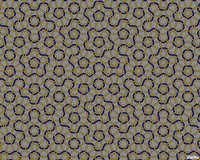The Binding Problem
 The "binding problem" refers to the fact that we experience the world as consisting of unitary objects, and yet all the information pertaining to any specific object is processed within vastly different regions of cortex. How does the brain know how to integrate the correct features into our experience of each object? Attention has been proposed in multiple theories (Treisman & Gelade, 1980; Wolfe, 1994) to be a kind of “glue” which integrates these anatomically distinct pattern activations into unitary objects representations.
The "binding problem" refers to the fact that we experience the world as consisting of unitary objects, and yet all the information pertaining to any specific object is processed within vastly different regions of cortex. How does the brain know how to integrate the correct features into our experience of each object? Attention has been proposed in multiple theories (Treisman & Gelade, 1980; Wolfe, 1994) to be a kind of “glue” which integrates these anatomically distinct pattern activations into unitary objects representations. One such theory of attention, Treisman’s Feature Integration Theory (FIT), posits preattentive and parallel feature detection, with serial deployments of attention binding these features into object files on a master “activity map.” Any stimuli falling within the focus of attention can be processed in parallel (i.e., the “group scanning hypothesis,” Quinlan, 2003).
Although initially too simplistic to account for behavioral data showing flat-response times for conjunctive searches (Quinlan, 2003), and despite subsequently detailed elaboration (e.g., “group scanning hypothesis,” and Wolfe’s related but distinct Guided Search model), several aspects of this attention/pattern-recognition relationship remain unsatisfactory.
First, the “glue” metaphor of attention does not always clearly relate to the biology of pattern recognition. For example, one might expect the features that cause “pop out” to map cleanly onto primary visual areas (PVA), but they do not: e.g., attention is required to discriminate oriented lines differing by less than 5˚, even though cells in V1 can reliably differentiate them (Wolfe, 2003).
Wolfe & Horowitz (2004) explained this difference as a function of signal-to-noise ratio, or alternately, target to distractor difference (TD). According to this view, “pop out” tasks are those manifesting a very large TD difference, and hence guide attention to the target almost immediately, whereas targets with a lower TD difference generally require longer to be detected. This viewpoint accurately portrays attention as sensitive to pattern heterogeneity.
However, the relationship between attention and pattern recognition described above contains a second, related problem: at what point in the pattern recognition process, and hence on what kinds of representations, does attention operate? This question will be reviewed in detail in upcoming posts.
Related Posts:
Binding through Synchrony: Proof from Developmental Robotics
References:
Treisman, A., Gelade, G. (1980) A feature-integration theory of attention. Cognitive Psychology, 1980 Jan;12(1):97-136.
Wolfe, J.M. (1994) Guided Search 2.0: A Revised Model of Visual Search. Psychonomic Bulletin & Review, 1(2): 202-238
Wolfe JM. (2003) Moving towards solutions to some enduring controversies in visual search. Trends Cogn Sci. 2003 Feb;7(2):70-76.
Wolfe, JM & Horowitz TS. (2004). What attributes guide the deployment of visual attention and how do they do it? Nature Reviews Neuroscience, Jun;5(6):495-501
Quinlan PT. (2004). Visual feature integration theory: past, present, and future. Psychol Bull. 2003 Sep;129(5):643-73


0 Comments:
Post a Comment
<< Home